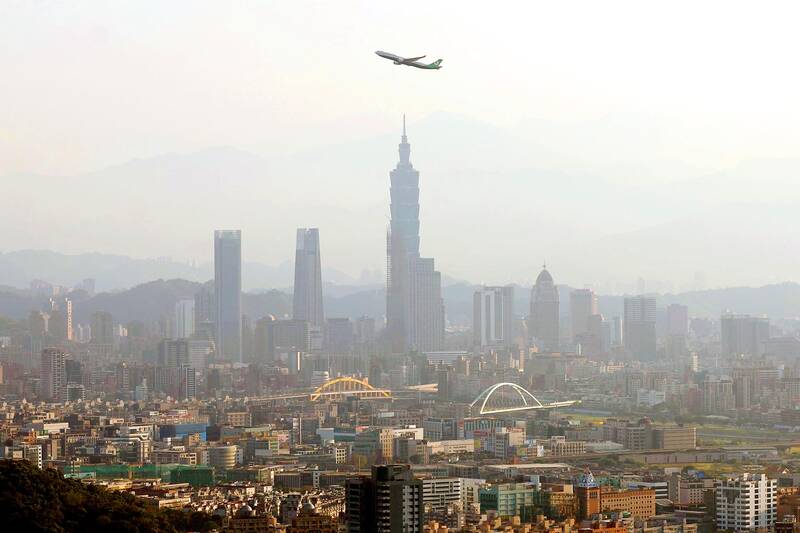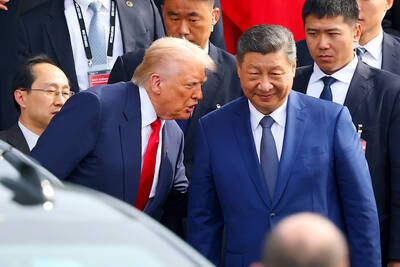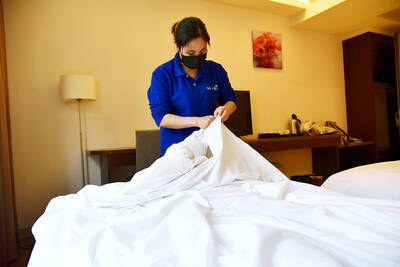International visitors transiting in Taiwan are to pay a NT$500 (US$16.33) airport service fee under a new policy to be implemented on March 31, the Ministry of Transportation and Communications said yesterday.
It would be the first time the government has levied airport service fees on transit passengers since Taiwan Taoyuan International Airport began operations in 1979.
Department of Navigation and Aviation Deputy Director Han Chen-hua (韓振華) told a news conference that the fee should be included in fares when people book flights.

Photo: CNA
If the fee is not included in fares, passengers can pay it at airport check-in counters, Han said, adding that it would be refunded if they do not transit in Taiwan.
Currently, only outbound travelers are charged NT$500 per person for using services and facilities at the airport.
The average transit layover at Taoyuan airport is about five hours, ministry data showed.
The user-pays principle should apply to transit passengers, as they access airport services just as outbound passengers do, Han said.
“Airports near Taiwan have already begun charging transit passengers for using airport service facilities, including Narita International Airport in Japan, Incheon International Airport in South Korea and Changi International Airport in Singapore,” he said.
Taoyuan “airport has adopted disease prevention measures to comply with the government’s policy to contain COVID-19 and during the pandemic it upgraded facilities to elevate service quality,” he said.
Of the 48.68 million people who accessed Taoyuan airport in 2019, 24.18 million were outbound travelers and 2.96 million were transit passengers, Han said.
About 80 percent of the transit passengers were people traveling from North America to Southeast Asia via Taiwan, he said.
Before the pandemic, the airport collected about NT$10.6 billion in airport service fee revenue per year, he said.
Based on the number of transit passengers in 2019, the new policy could add NT$1.5 billion to revenue per year, he added.
Taoyuan airport has flights to 63 destinations around the world, Han said.
About 1,400 flights depart from the airport per week, which is about 60 percent of the weekly flights in 2019, he said.
About 4.09 million passengers accessed the airport in the first two months of this year, about 52 percent of the number in the same period in 2019, he said.
“As there has been a significant rebound in air travel, the number of people accessing Taoyuan airport could exceed 20 million this year,” he said. “The number of transit passengers could reach 1.2 million this year, which could bring in additional revenue of about NT$550 million.”
The additional revenue would help pay for the construction of the airport’s third terminal and third runway, as well as a new terminal at Kaohsiung International Airport, he said.
The airport service fee for transit passengers is about NT$360 at Narita, NT$250 at Incheon, NT$925 at Hong Kong and NT$200 at Changi International, he added.

CALL FOR SUPPORT: President William Lai called on lawmakers across party lines to ensure the livelihood of Taiwanese and that national security is protected President William Lai (賴清德) yesterday called for bipartisan support for Taiwan’s investment in self-defense capabilities at the christening and launch of two coast guard vessels at CSBC Corp, Taiwan’s (台灣國際造船) shipyard in Kaohsiung. The Taipei (台北) is the fourth and final ship of the Chiayi-class offshore patrol vessels, and the Siraya (西拉雅) is the Coast Guard Administration’s (CGA) first-ever ocean patrol vessel, the government said. The Taipei is the fourth and final ship of the Chiayi-class offshore patrol vessels with a displacement of about 4,000 tonnes, Lai said. This ship class was ordered as a result of former president Tsai Ing-wen’s (蔡英文) 2018

UKRAINE, NVIDIA: The US leader said the subject of Russia’s war had come up ‘very strongly,’ while Jenson Huang was hoping that the conversation was good Chinese President Xi Jinping (習近平) and US President Donald Trump had differing takes following their meeting in Busan, South Korea, yesterday. Xi said that the two sides should complete follow-up work as soon as possible to deliver tangible results that would provide “peace of mind” to China, the US and the rest of the world, while Trump hailed the “great success” of the talks. The two discussed trade, including a deal to reduce tariffs slapped on China for its role in the fentanyl trade, as well as cooperation in ending the war in Ukraine, among other issues, but they did not mention

HOTEL HIRING: An official said that hoteliers could begin hiring migrant workers next year, but must adhere to a rule requiring a NT$2,000 salary hike for Taiwanese The government is to allow the hospitality industry to recruit mid-level migrant workers for housekeeping and three other lines of work after the Executive Yuan yesterday approved a proposal by the Ministry of Labor. A shortage of workers at hotels and accommodation facilities was discussed at a meeting of the legislature’s Transportation Committee. A 2023 survey conducted by the Tourism Administration found that Taiwan’s lodging industry was short of about 6,600 housekeeping and cleaning workers, the agency said in a report to the committee. The shortage of workers in the industry is being studied, the report said. Hotel and Lodging Division Deputy Director Cheng

‘SECRETS’: While saying China would not attack during his presidency, Donald Trump declined to say how Washington would respond if Beijing were to take military action US President Donald Trump said that China would not take military action against Taiwan while he is president, as the Chinese leaders “know the consequences.” Trump made the statement during an interview on CBS’ 60 Minutes program that aired on Sunday, a few days after his meeting with Chinese President Xi Jinping (習近平) in South Korea. “He [Xi] has openly said, and his people have openly said at meetings, ‘we would never do anything while President Trump is president,’ because they know the consequences,” Trump said in the interview. However, he repeatedly declined to say exactly how Washington would respond in